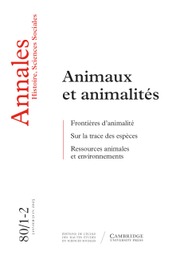Article contents
Approche généalogique d'une population insulaire : Terre-de-Haut des Saintes, dans la Caraïbe
Published online by Cambridge University Press: 25 May 2018
Extract
En présence d'une population isolée et réduite — par excellence, une population insulaire — dont tous les membres se proclament plus ou moins « cousins », la tentation est grande pour le chercheur de déchiffrer le tissu parental d'une telle société en établissant les liaisons des individus les uns aux autres, au travers de chaînes généalogiques s'étendant sur un maximum de générations, et en définissant ainsi un « objet » historique qui relie population présente et population passée. Lorsque de surcroît cette population insulaire est métissée, issue de deux stocks geniques initiaux, et qu'elle se situe dans une région du monde où les traits physiques servent de signes sociaux et d'indicateurs hiérarchiques, la restitution des généalogies acquiert un supplément d'importance : elle peut en effet contribuer à la connaissance du processus biologique de miscégénation où se confrontent les groupes de départ ; elle peut surtout, en raison de la liaison intime entre « race » et statut, permettre d'accéder à ce lieu privilégié où l'histoire biologique incarne en fait une histoire sociale... Ainsi s'est développée une bonne part de notre problématique, lors de l'étude de la population de la petite île de Terre-de-Haut des Saintes, dans la Caraïbe.
Summary
The island of Terre-de-Haut is part of the Saintes, a group of islands off the coast of Guadeloupe. Populated in the seventeenth century, it now supports a population of 1500, often called "poor whites". Unlike the rest of the region, the black element never came to prevail, since no plantations could be organized in the island. The study ofsuch a small, isolated, largely endogamous population sample makes it possible to trace the network of family ties for several generations. On the basis of the abundant data provided by the records of the etat civil, the use of computers was possible. After reconstituting the different families on the island, and applying the tools of historical demography, the author succeeded in tracing the various lineages back to their original ancestors. Such an approach confers new interest to the study of family structures, frequent in Caribbean studies, and allows for the development a demographie model proper to the island. Ultimately, this approach allows one to confront the problems raised by matrimonial economy, particulary the process of miscegenation, since the whole population derives from two different initial genetic stocks. The reconstitution of family trees takes on added importance, the relationship between race and social status make this island a privileged place where biological history and social history meet and merge. A close survey of two lines of descent suggests that no obstacles existed to intermixing and that this is a population relatively sheltered firom contact with the outside world, a fact which emphasizes the originality of the population.
- Type
- Les Amériques
- Information
- Copyright
- Copyright © Les Éditions de l’EHESS 1980
References
Bibliographie Complémentaire
- 1
- Cited by


